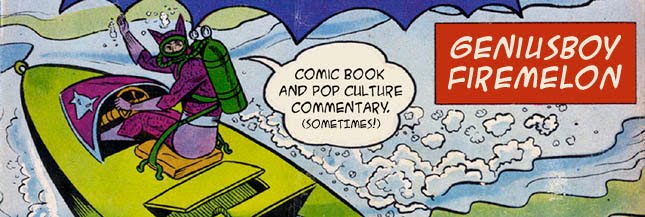 If you remember your 1990s comics, you'd recall that JLA #16 features the villain Prometheus (who had posed as the heroic Retro--winner of the "Join the JLA for a Day Contest) and his attempt to infiltrate the Watchtower and eliminate the League members one at a time. Take a look at his dialogue in this panel here. "I'm taking them down one by one," he says. "Ten Little Indians." This is, of course, exactly the premise (and Agatha Christie plot) that we see in the current Batman #668. The difference is in the execution, as the JLA story is full of superhero bombast and fisticuffs while the Batman story is all mood and suspense. Nevertheless, it's a clear example of Morrison returning to tell almost the same story after nearly a decade. (And, in both cases, the story seems to be one of the highlights of his run on the titles.)
If you remember your 1990s comics, you'd recall that JLA #16 features the villain Prometheus (who had posed as the heroic Retro--winner of the "Join the JLA for a Day Contest) and his attempt to infiltrate the Watchtower and eliminate the League members one at a time. Take a look at his dialogue in this panel here. "I'm taking them down one by one," he says. "Ten Little Indians." This is, of course, exactly the premise (and Agatha Christie plot) that we see in the current Batman #668. The difference is in the execution, as the JLA story is full of superhero bombast and fisticuffs while the Batman story is all mood and suspense. Nevertheless, it's a clear example of Morrison returning to tell almost the same story after nearly a decade. (And, in both cases, the story seems to be one of the highlights of his run on the titles.) Another convergence, from the very same JLA story, comes on the page immediately following Prometheus's Agatha Christie allusion. As you can see in this panel here, a crooked house appears, representing entrapment in Limbo (Limbo turns out to be Prometheus's base of operations, as he's a "crooked man," and in the issue #16 story, he teleports the angel Zauriel there for safekeeping). This image of a crooked house seems to converge with Batman #668 also, specifically with the J.H. Williams III cover. In issue #668, Batman is never literally shown inside a twisted house--the cover is a symbolic image, showing the hero trapped helplessly in a disorienting environment as the grip of the Black Glove threatens his life. The house is a metaphor, on the cover, of his current emotional state. It's not much of a stretch to connect that convergence with yet another: Arkham Asylum--a graphic novel predicated on the idea that a house (the asylum) is the fragmented psyche of Batman.
Another convergence, from the very same JLA story, comes on the page immediately following Prometheus's Agatha Christie allusion. As you can see in this panel here, a crooked house appears, representing entrapment in Limbo (Limbo turns out to be Prometheus's base of operations, as he's a "crooked man," and in the issue #16 story, he teleports the angel Zauriel there for safekeeping). This image of a crooked house seems to converge with Batman #668 also, specifically with the J.H. Williams III cover. In issue #668, Batman is never literally shown inside a twisted house--the cover is a symbolic image, showing the hero trapped helplessly in a disorienting environment as the grip of the Black Glove threatens his life. The house is a metaphor, on the cover, of his current emotional state. It's not much of a stretch to connect that convergence with yet another: Arkham Asylum--a graphic novel predicated on the idea that a house (the asylum) is the fragmented psyche of Batman. I don't know if Morrison directed Williams III to depict a type of crooked house on the cover of Batman #668, but the covergence remains. The patterns continue. To make a convergence of our own, let's recall the words of the multi-dimensional being Iok Sotot from Morrison's first major superhero comic: Zenith. He blissfully declares, "I love to watch the mindless patterns they make in spacetime."

3 comments:
I can't tell from the way you word it... did you know that Agatha Christie had a novel called Crooked House?
I did not. Yet another convergence. Thanks!
So what you're saying is that this will lead to Wingman getting disabled by Catwoman hitting him in the balls with a bullwhip?
Post a Comment